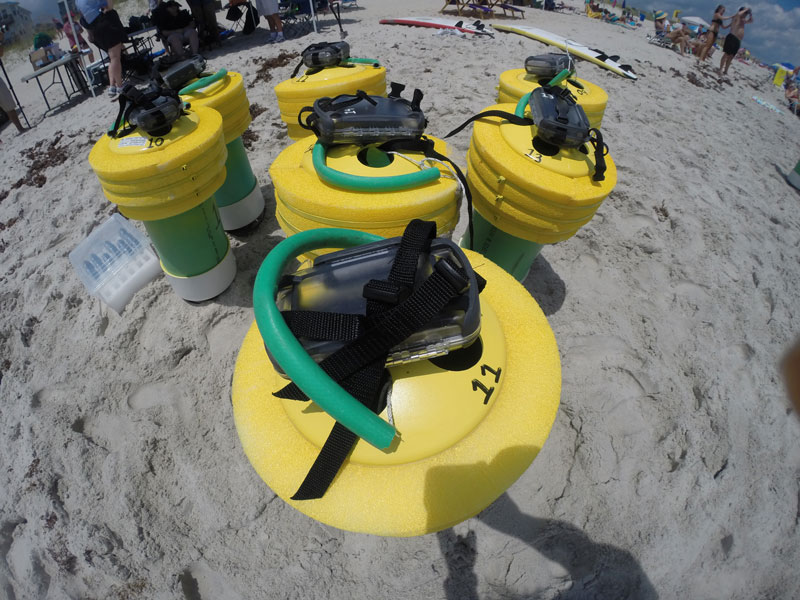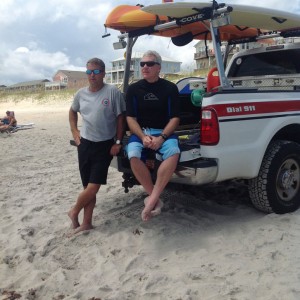You may have noticed that North Carolina Sea Grant’s rip current research is getting media attention — both traditional and social.
So, what does a data-logging drifter do?

Data-logging drifters are used to monitor rip currents. Photo by Kurt Christiansen, courtesy North Carolina Sea Grant.
“It records position over time. It also can record velocities, so we don’t have do it manually,” explains Cobi Christiansen, who is gathering and analyzing the GPS and other data for his graduate studies at the University of North Carolina Wilmington.
“Basically, it can run for about two days worth of data,” he says of the 2GB memory card that will outlast the battery life.
“We can run these things all day long and not have to worry. After the deployment, we go through, download the data, reformat the card, and do it again.”
The drifters are made from readily available plumbing materials, along with the small, off-the-shelf GPS units. Gym weights and insulation combine to allow each drifter to float like a person would.
Here’s some footage Christiansen shot in the water.
Spencer Rogers, our coastal construction and erosion specialist, is leading a team of researchers and volunteers focused on beach safety.
“In North Carolina, the ‘rip current danger’ on most beaches are only about five days a year. Those rip currents flow faster than Michael Phelps can swim,” Rogers told local, state and national media at a deployment this week.
While rip current research has been done previously elsewhere, Rogers adapted the equipment and process to better suit North Carolina’s coast.
“A lot of the research has been done internationally especially Australia and the west coast of the United States and not a lot of research has been done here,” Christiansen told Time Warner Cable News.
Rob Brander — a coastal geomorphologist from the University of New South Wales in Sydney, Australia — is contributing his expertise while visiting the United States to study rip currents.

Simon Sanders and Rob Brander oversee drifter deployment to monitor rip currents. Photo by Rebecca Nagy.
“There is this complacency, because they might only kill one or two people at a time,” Brander, also known internationally as Dr. Rip, told The News and Observer. “In Australia, they don’t get much attention, but they kill more people than cyclones, bush fires, floods and sharks combined.”
Brander says he is impressed with the rip current outlooks provided by the National Weather Service. The NWS forecast office in Wilmington has been a key partner in project design and deployments. The Newport/Morehead City office will work with the team during data collection on the Outer Banks.
Lifeguards provide the important daily experience with rip currents. Simon Sanders, who leads the Carolina Beach Ocean Rescue crew, has been a key partner.
For the rest of the summer, Rogers and his team will be on-call to respond when lifeguards report, or the NWS offices forecast, strong rip currents.
North Carolina Sea Grant is headquartered at North Carolina State University with offices in Manteo, Morehead City and Wilmington. Learn more.
Rebecca Nagy, a senior at NC State, has written for Coastwatch magazine.